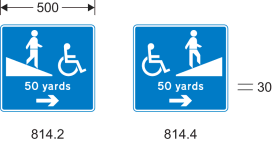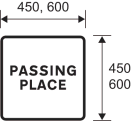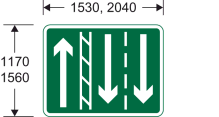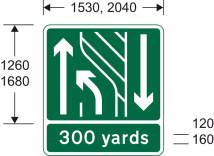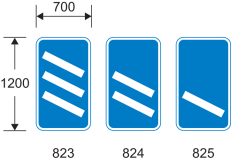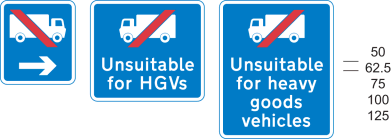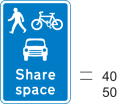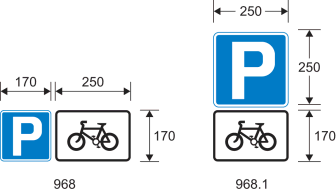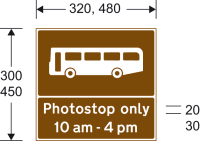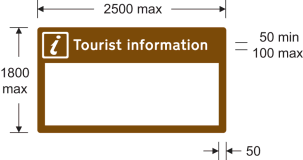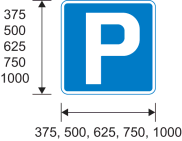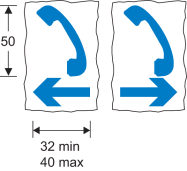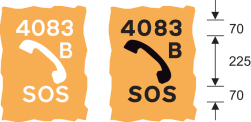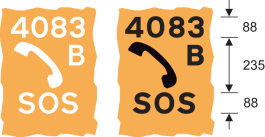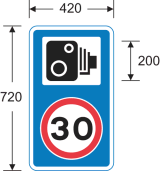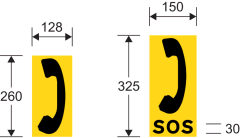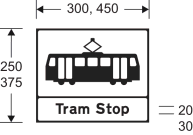| 1 | Diagram 811A and 811B
Beginning and end of section of road where traffic has priority over vehicles from the opposite direction
| | 1, 2 | | |
| 2 | Diagram 810
One-way traffic
(Sign for pedestrians)
(Alternative types)
| | | 5 | |
| 3 | Diagrams 814.2 and 814.4
Ramped access to or from a pedestrian subway or overbridge
| | 1, 2, 4, 5, 54 | 5 | |
| 4 | Diagrams 814.1 and 814.3
Stepped access to and from a pedestrian subway or overbridge
| | 4 | 5 | |
| 5 | Diagram 816
No through road for vehicular traffic
(Alternative types)
| | | | |
| 6 | Diagram 816.1
Alternative to the sign shown at item 5 with a street nameplate
| | 7 | 5 | |
| 7 | Diagram 817
No through road for vehicular traffic in direction indicated from junction ahead
(Alternative types)
| | 6 | | |
| 8 | Diagram 821
Road ahead only wide enough for one line of vehicles, and providing information about passing places
(Alternative types)
| | 1 | | |
| 9 | Diagram 822
Passing place on narrow road
| | | | |
| 10 | Diagrams 892 and 893
Name and length of a tunnel on a motorway (892) or all‑purpose road (893)
| | 8 | | |
| 11 | Diagram 818.1
Section of dual carriageway road ahead
| | 1, 2 | | |
| 12 | Diagram 818.1A
Distance over which a short length of dual carriageway road beginning directly ahead extends
(Alternative types)
| | | | |
| 13 | Diagram 820.1
Absence of hard shoulder for the distance shown
(Alternative types)
| | 1 | | |
| 14 | Diagrams 873 and 874
Additional traffic joining from the left or right ahead (diagram shows blue background – for use on motorways)
| | 1, 2, 6, 26, 27 | | |
| 15 | Diagram 872.1
The number of traffic lanes reduces ahead
(diagram shows blue background – for use on motorways)
(Alternative types)
| | 1, 2, 6, 26, 27 | | |
| 16 | Diagram 887
Overtaking lane ahead
| | 1, 2 | | |
| 17 | Diagram 888
Indication of length of road over which an overtaking lane is available on a single carriageway road, with a single traffic lane in the opposite direction
(diagram shows green background – for use on primary routes)
| | 1, 27 | | |
| 18 | Diagram 889
Indication that only one lane of traffic, with no overtaking, is available on a single carriageway road with two traffic lanes in the opposite direction (diagram shows green background – for use on primary routes)
| | 27 | | |
| 19 | Diagram 890
Distance ahead to a point where an overtaking lane ends on a single carriageway road (diagram shows green background – for use on primary routes)
| | 1, 2, 27 | | |
| 20 | Diagram 891
Distance ahead to a point where an overtaking lane ends on a single carriageway road on the approach to a dual carriageway road with only one traffic lane in each direction
(diagram shows green background – for use on primary routes)
| | 1, 2, 27 | | |
| 21 | Diagrams 823, 824 and 825
Distance in hundreds of yards to a roundabout or the next point at which traffic may leave a route (diagram shows blue background – for use on motorways)
| | 4, 26, 27 | | |
| [21A | Diagrams 823.1, 824.1 and 825.1
Distance in hundreds of yards to the point that a reduced maximum speed limit begins (diagram shows dark green background for use on primary routes)
| | 4, 59, 60 | 16] | |
| 22 | Diagram 877
Appropriate traffic lanes for different manoeuvres at a junction ahead
(diagram shows white background – for use on non-primary routes)
(Alternative types)
| | 9, 26, 28 | | |
| 23 | Diagram 820
Route unsuitable for type of vehicle indicated
(Alternative types)
| | 5(1) | | |
| 24 | Diagram 820A
Road unsuitable for heavy goods vehicles
(Alternative types)
| | 4, 5(1) | | |
| 25 | Diagram 829.5
Area where police carry out checks on the speed of vehicles
| | | | |
| 26 | Diagram 829.6
Waiting place for police or authorised vehicles only
(Alternative types)
| | | | |
| 27 | Diagram 881
Start of a home zone designated under section 268 of the Transport Act 2000(), or section 74(1) of the Transport (Scotland) Act 2001()
| | 24 | | |
| 28 | Diagram 882
End of a home zone indicated by the sign at item 27
| | | | |
| 29 | Diagram 886
Road ahead where motorists, cyclists [, drivers of electric scooters being used in a trial] and pedestrians should expect to share the same space
| | | | |
| 30 | Diagram 884
Start of a quiet lane in England designated under section 268 of the Transport Act 2000
| | 24 | | |
| 31 | Diagram 885
End of designated quiet lane in England
| | | | |
| 32 | Diagram 883
Indication of the start of area with traffic calming features (within the meaning of paragraph 1(3) of the Schedule 10 General Directions)
| | 1, 5(1), 24 | | |
| [32A | Diagram 883.1
In relation to Wales, end of traffic calmed area]
| | | | |
| 33 | Diagram 953.3
Entrance to a bus station, depot or garage
| | | 5 | |
| 34 | Diagram 962
Bus lane or lanes on a road at junction ahead, with indication of times of operation
(Alternative types)
| | 10 | | |
| 35 | Diagram 962.1
Cycle lane on a road at junction ahead [or, if applicable, a cycle track crossing road, or a way that would be a cycle track but for it being accessible, under a temporary statutory provision, by electric scooters being used in a trial,] with indication of times of operation
| | 4, 10, 12 | | |
| 36 | Diagram 962.2
Contraflow bus lane ahead on a road at a junction which pedal cycles [and electric scooters being used in a trial] may also use
(Alternative types)
| | | | |
| 37 | Diagram 958
With-flow bus lane ahead which authorised vehicles, solo motor cycles, pedal cycles [, electric scooters being used in a trial] and taxis may also use, with indication of times of operation [and where the pedal cycle symbol represents, where relevant, electric scooters being used in a trial]
| | 10, 11, 13, 14 | | |
| 38 | Diagram 958.1
With-flow mandatory cycle lane ahead, with indication of times of operation
| | 10, 14 | | |
| 39 | Diagram 2602.2
Numbered route for pedal cycles [and electric scooters being used in a trial] forming part of a regional (blue number patch) or national (red number patch) cycle route network
(Alternative types)
| | 25 | 5 | |
| 40 | Diagram 963
Direction in which pedestrians should look for approaching traffic when crossing a bus lane
(Alternative types)
| | | 5 | |
| 41 | Diagram 963.1
Direction in which pedestrians should look for approaching pedal cycles [and electric scooters being used in a trial] when crossing a cycle lane [or, if applicable, cycle track, or a way that would be a cycle track but for it being accessible, under a temporary statutory provision, by electric scooters being used in a trial]
(Alternative types)
| | 15 | 5 | |
| 42 | Diagram 963.2
Direction in which pedestrians should look for approaching traffic when crossing a contraflow bus lane which pedal cycles [and electric scooters being used in a trial] may also use
(Alternative types)
| | | 5 | |
| 43 | Diagram 963.3
Direction in which pedestrians should look for approaching tramcars when crossing a tramway
(Alternative types)
| | | 5 | |
| 44 | Diagram 967
Route recommended for pedal cycles [and electric scooters being used in a trial] on the main carriageway of a road
| | | 5 | |
| 45 | Diagram 965
End of cycle lane, track or route
| | | 5 | |
| 46 | Diagram 966
Pedal cyclists [and drivers of electric scooters being used in a trial] to rejoin main carriageway or dismount at the end of, or at a break in, a cycle track or route
(Alternative types)
| | | 5 | |
| 47 | Diagram 968 and 968.1
Parking place for pedal cycles
| | | 5 | |
| 48 | Diagram 857.1
Information relating to a taxi rank for the number of taxis specified
| | 16 | 5 | |
| 49 | Diagram 2934
Drivers should keep or check their distance from the vehicle in front
(Alternative types)
| | | | |
| 50 | Diagram 2933
Drivers should keep a distance of two chevron markings (the markings provided for at item 34 of the table in Part 4) from the vehicle in front
| | | | |
| 51 | Diagrams 2032 and 2130
Primary route (2032) or non‑primary route (2130) forming part of a ring road
| | | | |
| 52 | Diagram 972
Stopping place for buses used for carrying tourists to allow passengers to take photographs
| | 17, 34 | 5 | 2 |
| 53 | Diagram 857A
Information for pedestrians about tourist destinations and leisure facilities in a nearby place or area
| | 18, 19 | 5 | |
| 54 | Diagram 857B
Information for pedestrians about tourist destinations and leisure facilities in a nearby place or area
| | 18 | 5 | |
| 55 | Diagram 2501
Distance to a parking place ahead
| | [1] [1A] , 5(1) | | |
| 56 | Diagram 801
Parking place
| | | | |
| 57 | Diagram 2713.1
Distance ahead to emergency telephone in a parking place or emergency lay‑by
(Alternative types)
| | 1, 2, 5 | | |
| 58 | Diagram 2713
Direction to nearest emergency telephone on same side of the road(diagram shows blue background – for use on motorways)
(Alternative types)
| | 53 | 5 | |
| 59 | Diagram 2714
Side of emergency telephone box
(Alternative types)
| | 29, 55 | 2, 6 | |
| 60 | Diagram 2715
Back of emergency telephone box
(Alternative types)
| | 29, 55 | 2, 6 | |
| 61 | Diagram 2718
Route number and location reference
| | 29 | | |
| 62 | Diagram 2712
Location of fire rendezvous point
(Alternative types)
| | 20 | 5 | |
| 63 | Diagram 878
Area in which enforcement cameras are in use
(Alternative types)
| | 21 | | |
| 64 | Diagram 880
[In relation to England,] speed camera ahead on a lit road and reminder of 30 mph speed limit
| | 21(2) | | |
| [64A | Diagram 880.2
In relation to Wales, speed camera ahead on a lit road and reminder of 20 mph speed limit
| | 21 (2)] | | |
| 65 | Diagram 880.1
Speed camera ahead on an unlit road and reminder that a national speed limit applies
| | 21(2) | | |
| 66 | Diagrams 827.1, 827.2 and 827.3
Hospital ahead
| | 22 | | |
| 67 | Diagram 775
Vehicular traffic must not stop within the area of a railway or tramway level crossing
| | | | |
| 68 | Diagram 783
Drivers of long low, large or slow vehicles must telephone to obtain permission before using a railway or tramway level crossing
(Alternative types)
| | | | |
| 69 | Diagram 785.1
Name of level crossing and details of telephone number for contacting railway or tramway operator
| | 23 | | |
| 70 | Diagram 786
Place where large, slow or long low vehicles should wait near a railway or tramway level crossing while the driver obtains permission by telephone to cross or confirms he or she has crossed
(Alternative types)
| | 56 | | |
| 71 | Diagram 787
Site of telephone or emergency telephone at or near a railway or tramway level crossing
(Alternative types)
| | | | |
| 72 | Diagram 788
Direction to telephone or emergency telephone at or near a railway or tramway level crossing
(Alternative types)
| | | | |
| 73 | Diagram 611
Vehicular traffic may reach the same destination by proceeding either side of the sign
| | | 1, 4 | 1 |
| 74 | Diagrams 833, 834, 835 and 836
Signs regulating the movement of vehicular traffic into and out of premises with more than one access to a road
| | | 5 | |
| 75 | Traffic mirror for providing additional visibility (not for use with traffic signals) | The mirror must be convex and any frame must be of a single colour, being black, grey, yellow or white | | 13 | |
| 76 | Diagram 970
Stopping place for buses
| | 30, 31, 34 | 5 | 2 |
| 77 | Diagrams 973.2 and 973.3
Stopping place for buses operated by or on behalf of, or under agreement with, Transport for London
| | 30, 32, 34 | 5 | 2 |
| 78 | Diagram 971
Stopping place for tramcars
| | 30, 33, 34 | 5 | 2 |
| 79 | Diagram 2928
Motorway sign indicating the boundary of an administrative area, a ceremonial area or an historic county area
(Alternative types)
| | 35 | | |
| 80 | Diagram 2401
Primary or non‑primary route sign indicating the boundary of an administrative area, a ceremonial area or an historic county area
| | 30, 36 | 5 | |
| 81 | Diagram 2402.1
Primary or non‑primary route sign indicating the name of a city, town or village commencing immediately ahead
(Alternative types)
| | 37 | 5 | 3 |
| 82 | Diagram 2403.1
Primary or non-primary route sign indicating the name of a city, town or village immediately ahead, together with extra local information
| | 30, 38 | 5 | 4 |
| 83 | Diagram 2404
Primary or non-primary route sign indicating the name of a city, town, village, an administrative area, a ceremonial area or an historic county area immediately ahead, together with phrase and image that is representative of the city, town, village or area
| | 39 | 5 | 4 |
| 84 | Diagram 976
Maximum speed limit for tramcars in kilometres per hour
| | 40 | 5 | |
| 85 | Diagram 864.2
Vehicle testing station approved by the Driver and Vehicle Standards Agency
| | 58 | 5 | |
| 86 | Diagram 865
Motor cycle test centre
| | | 5 | |


